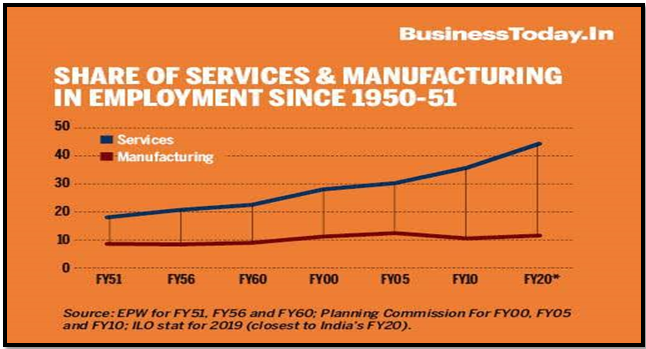WHY INDIA NEEDS DEEP INDUSTRIALIZATION
Syllabus:
- GS 3: Effects of Liberalization on the Economy, Changes in Industrial Policy and their Effects on Industrial Growth.
Focus:
- The aftermath of the COVID-19 pandemic has reshaped global economic perspectives.
- Retreat from globalization is evident, with an increasing focus on industrial policy and state-led economic interventions.
- Prominent examples include the Inflation Reduction Act in the U.S., the European Green Deal, and India’s Atmanirbhar Bharat.
India’s Growth Dynamics:
- Despite a quick recovery from the pandemic, India faces the challenge of “premature deindustrialization.”
- High growth benefits a small minority, leaving common people grappling with high food prices.
- Structural issues in India’s growth model have led to stagnation in manufacturing and persistent gaps.
- The puzzle of why India struggles to break out of industrial stagnation and generate employment is explored.
- Raghuram Rajan and Rohit Lamba propose an unconventional perspective in “Breaking the Mould: Reimagining India’s Economic Future.”
Source: Business Today
Historical Context and Crossroads:
- India’s manufacturing share in output and employment has consistently been below 20%, even post-1991 economic reforms.
- India is at a crossroads with stagnant industrial investment, high unemployment, and chronic disguised unemployment.
- Trade deficit widens as the country struggles to produce goods for domestic consumption, let alone exports.
| India’s Industrial Policy
Objectives of India’s Industrial Policy: 1. Sustained Growth in Productivity: Aimed at maintaining consistent productivity growth across industries. 2. Enhanced Gainful Employment: Focuses on creating more job opportunities in various sectors of the economy. 3. Optimal Utilization of Human Resources: Strives to utilize the workforce efficiently to maximize output and economic growth. 4. Achieving International Competitiveness: Aims to enhance the competitiveness of Indian industries in the global market. 5. Transformation into a Global Player: Seeks to position India as a major player in the global economic landscape. |
Evolution of Industrial Policies in India:
Industrial Policy Resolution of 1948:
- Established a mixed economic model, categorizing industries into strategic, key, important, and other sectors.
- Introduced the Industries (Development and Regulation) Act, 1951 to implement the policy.
Industrial Policy Statement of 1956
- Emphasized expanding the public sector, promoting cooperative sectors, and preventing the rise of private monopolies.
- Classified industries into three categories based on their ownership and control.
Industrial Policy Statement of 1977:
- Focused on promoting cottage and small industries, reducing labour unrest, and restricting the dominance of large-scale units.
Industrial Policy of 1980:
- Aimed at raising the efficiency of the public sector and reversing the trend of industrial production decline.
New Industrial Policy of 1991:
- Introduced liberalization measures, including de-reservation of public sectors, de-licensing, disinvestment, and liberalization of foreign investment.
- Led to the removal of bureaucratic hurdles and increased competition in the economy.
Limitations of Industrial Policy:
- Stagnation of the manufacturing sector’s contribution to GDP.
- Selective inflow of investments causing distortions in the industrial pattern.
- Displacement of labour due to restructuring and modernization.
- Lack of incentives for improving efficiency and vaguely defined industrial location policies.
Critique of Services-Led Growth:
- Services-led growth exhibits poor employment elasticity.
- Inequality in the service sector is higher than in manufacturing, contributing to social disparities.
- Early investments in higher education contribute to the neglect of mass school education.
- Unequal distribution of human capital investments, hindering inclusive growth.
- Differential returns to education across classes and social groups.
- Majority first-generation graduates face poor returns on their education investments, amplifying existing inequalities.
- Rajan and Lamba’s argument challenges conventional wisdom by promoting high-skill services powered by information technology to stimulate manufacturing.
- Contrast with India’s current industrial policy, raising questions about potential consequences.
Way Forward / What needs to be done?
- Prioritizing Deep Industrialization:
Highlighting the need for a strong emphasis on deep industrialization as opposed to the prevailing emphasis on the service sector.
- Recognizing Industrialization’s Transformative Impact:
Emphasizing the transformative potential of industrialization in reshaping the fundamental aspects of society.
- New Industrial Policy:
Need for a comprehensive new industrial policy to address current challenges and boost manufacturing.
- Policy Reforms:
Continued reforms to improve ease of doing business, address regulatory burdens, and attract investment.
- Infrastructure Development:
Address issues like electricity shortages, credit constraints, and high labour costs through infrastructure development.
- Campaigns and Initiatives:
Build on initiatives like Make in India and Start-up India to enhance the business ecosystem.
- Global Competitiveness:
Focus on enhancing India’s global competitiveness by leveraging its strengths and addressing weaknesses.
Conclusion:
A nuanced understanding of India’s growth challenges, considering historical, educational, and cultural dimensions, is essential.
The call for deep industrialization aligns with addressing not only economic but also societal issues, laying the groundwork for a comprehensive transformation.
Mains Practice Question :
Discuss the imperative for India to prioritize deep industrialization in the wake of the global economic landscape reshaped by the COVID-19 pandemic.

 Source: Business Today
Source: Business Today

